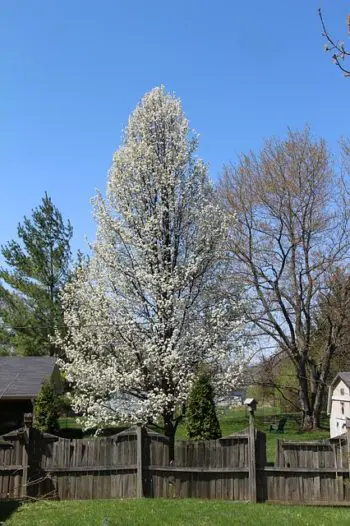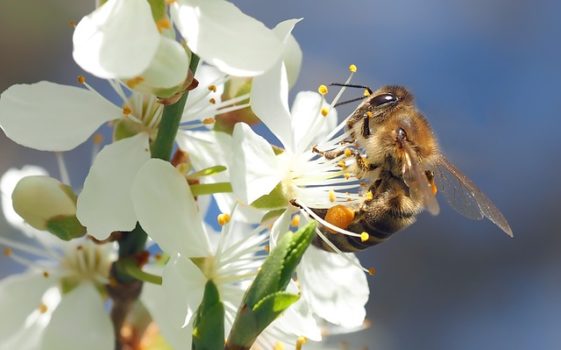With its recent rise in prevalence and early bloom cycle, many apiarists are asking whether the Bradford Flowering Pear Tree is a good source of nectar and pollen for honey bees. The short answer is yes, these trees can be a good source of early nectar and pollen for bees, however, only until a better pollen source is available. Additionally, apiarists should be aware that the Bradford Flowering Pear Tree has recently come under heavy attack for its invasive properties and cross pollination mutations.
In some locations the Bradford Pear is one of the first blossoms that show up from which bees collect pollen. This can be a good boost for a honey bee colony after a long winter. In some areas the Bradford Pear is not the first tree to blossom, so other sources are worked and the Bradford Pear is bypassed.

Bradford Pear Trees in the Spring
When Bradford Pear Trees bloom in the spring it is hard not to take note. They are generally one of the first trees to blossom, and the clusters of blooms are visually stunning and quite spectacular. The large white ornamental blossoms pop like fireworks and often give neighborhoods a perfect fake movie-prop community look.
The smell of these blooms is nothing like the beauty of the flowers. The smell of the Bradford Pear Tree is sickly sweet, often described as akin to rotten fish. I know it isn’t my favorite, and has led me to wonder if the honey produced from these trees is bad tasting. From what many have said, the honey produced from Bradford Pear blossoms is not too bad, but certainly doesn’t compare to honey from other sources. (Not what you would call a rousing endorsement).
The Bradford Pear Tree Controversy
Prior to raising bees, I wasn’t aware that the Bradford Pear had so much controversy behind it. Though the Bradford Pear was introduced to the United States in the 1960’s, it didn’t become popular in the region where I was raised until recently. Instead, spring in my hometown was usually decorated with blossoms of the Bartlett Pear, Redhaven or Early Elberta Peach or Golden Delicious Apples, for consumption. Ornamental trees were typically of the evergreen or maple variety.
Once my home region became less agrarian, developers came in and planted copious numbers of ornamental Bradford Pear trees because they were showy, inexpensive, and quick to grow. It didn’t take long for folks to notice however, that these trees were relatively brittle and branches cracked or broke easily. If folks didn’t prune carefully, they would often break the branches. Additionally, sometimes the trees would grow too fast, causing the bark to burst, and the tree would die as quickly as it had grown.

Because I live at a moderately high elevation the Bradford Pear is one of the earliest plants to bloom each spring. Without fail, each year I have witnessed the local bee population work the blossoms of the Bradford Pear for a few days, only to abandon them as soon as a better source of nectar and pollen comes online. After seeing this behavior, I was led to question the environmental value of these sickly smelling trees that had become so prevalent in my neighboring community.
The further I delved into the agricultural literature and beekeeping forums the deeper the controversy surrounding these trees became. Some sources argue that the Bradford Pear is the best tree ever introduced to the United States, while others contend that the trees don’t produce anything for pollen collectors and are the bane of the environment.
My own research and experience has led me to believe that the Bradford Pear is not a good choice for landscapers or gardeners, as bees find their blossoms second-rate, and its cross-pollinated offspring are too unruly to control.
The Bradford Pear tree is native to Vietnam and China and was cultivated from the Callery tree. It was was introduced into the United States in the 1960’s by the department of Agriculture, which at the time, thought thought it was a perfect and sterile ornamental hybrid tree.
The Bradford Pear was touted for its incredible displays of white blossoms in the spring, its ability to maintain a small footprint and limited height that seemed perfect for burgeoning baby boomer neighborhoods and cities. If conditions were right the autumn foliage produces bright colored leaves ranging from yellow to orange and red. They are also tolerant of all kinds of soil acidity and soil drainage. According to these descriptors, the Bradford Pear certainly sounds like the perfect ornamental tree.
The Bradford Pear Tree was not the perfect tree that they had supposed. Originally the seeds of the Bradford Pear were thought of as too hard for birds to eat. However, this has proven untrue over time. When the trees self-pollinate the seeds are a bit too hard for the birds to digest and the seeds are sterile. When there is cross pollination however, the seeds become viable, and clusters of seedy berries appear that are extremely attractive to birds, who consume them and spread the seeds widely in their feces. From that point, the seeds germinate and become crossed offspring, or advanced and that is where the problems happen.
The offspring of cross-pollinated Bradford Pear trees are more genetically diverse and prolific, and don’t always have the same characteristics as their parent tree. Rather, the offspring trees will begin to exhibit some of the traits of the original cultivar, the Callery Tree. Some of the undesirable characteristics that show up are thick and gnarly thorns, root structures that choke out other vegetation, odd shapes, and prolific spreading capacity.
So when people ask whether bees like Bradford Pear trees, the answer is “Yes, the bees do.” The evidence is seen in the prolific spread of the tree. The bees are part of the cross pollination that creates these genetically advanced/nuisance offspring that are showing up all over the place.
I came across an interesting article here by Durant Ashmore, who calls his article “the curse of the Bradford Pear.” In the article, Ashmore rants that the Bradford Pear Tree is spreading and becoming a nuisance due to its “impenetrable thorny thickets that choke out the life out of pines, dogwoods, maples, redbuds, oaks, [and] hickories.”
Ashmore has an interesting and enjoyable writing style, and doesn’t hold back as he describes the Bradford Pear tree as an “Ecological Nightmare” and the landscapers who plant these trees “dimwitted” for doing so. He describes the damage being done by these trees as they spread,
“obliterating our wonderful native trees from the rural landscape.”
Indeed, the Bradford offspring that are showing up in the wild are creating quite a problem. When the thorns are present in the next generation from the original Bradford Pear, they can only be handled with certain equipment without damaging tires. These thorns have created a loss of value of forest land to the tune of $3,000 an acre.
In many areas of the United States the Bradford Pear has been designated an invasive species. The Bradford Pear Tree is becoming one of the worst trees to plant and have. It is proving to be a far cry from the original perfect ornamental tree it was originally touted to be.
Mindful landscapers, home owners, and agricultural designers are now using alternatives to the Bradford Pear. Some varieties that are suggested are:
- Japanese Zelkova
- Red Maple
- Chinese Pistache
- Trident Maple
- Crape Myrtle
- Peggy Clark Apricot
- Purple Leaf Plum
- Chinese Dogwood
- Redbud, Forest Pansy
- Columnar English Oak
I personally would suggest you plant a native species. You can find some great suggestions of native species if you contact your local extension service. I wrote an article here if you want a quick link to your state’s extension service. When you pick a native species, you are almost guaranteed to have a healthy tree that can handle your climate and environment. You will also have a lot less maintenance to deal with.
Summary
So, after all that I have found researching the flowering Bradford Pear tree. From a beekeeper’s point of view the flowering tree is used by bees but is probably not the first choice. If there is another choice the bees will go elsewhere.
It was interesting to see what all the controversy was about the Bradford Pear trees. I had no idea about the history of the trees. I do like to see the blossoms in the spring and the colorful leaves in the fall. I don’t like the smell of the things. Sometimes the smell of the flowers can become overbearing. I don’t blame a bee if it just steers clear of the things. After my research I think it’s probably a good idea to just stay away from the Bradford Pear Tree and admire it if you go to Vietnam or China.

